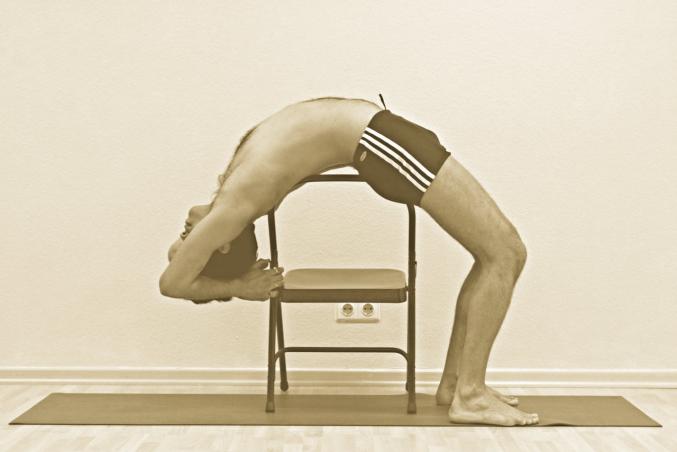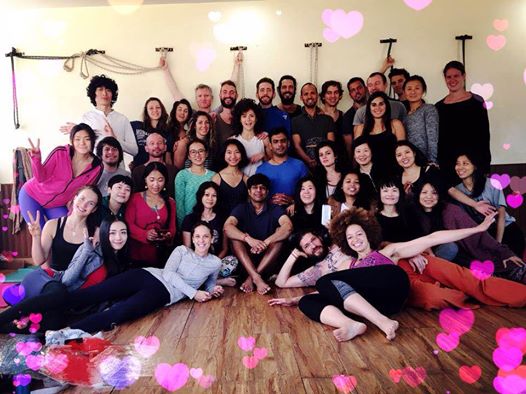Pankaj does not call his style Iyengar style, though his classes contain a lot of information on alignment and remind those of some Iyengar teachers. That’s not surprising as Pankaj has been studying with some of the best Iyengar teachers in India and abroad. That contributed a lot to his understanding of mechanics of the human body. However, he chose his own path of practice and his classes contain observations and techniques that he has discovered on his own, nobody else teaches certain asanas and approaches the way Pankaj does.
I have attended Pankaj’s course in December 2014 and I liked it tremendously. The course had a topic of backbends and the objective was to teach us the proper techniques of most advanced backbends through understanding the basics of human mechanics. Certainly, the course did not contain only backbends. It was a well-rounded practice that involved all families of asanas, including standing poses, balances, forwards bends, twists, but the focus was to give us tools to approach the most challenging back-bending poses with arsenal of knowledge and body intelligence that would make us perform them safely.
The course is designed for experienced students and focuses on making them be more aware of their bodies, and learn approaches and tricks to control it better. Over the time of these three weeks, Pankaj shows a path from simplest asanas towards the most challenging ones, developing awareness, motor control, strength, flexibility and endurance.
Because of such design of the course, drop-ins are not allowed. Each class is the foundation for the next one, and one cannot just drop in any random class without first learning the foundations. That’s why you need to subscribe to the entire course, and once you have started it, make sure you attend all the classes - two classes daily, to build capacities of your body and understanding of the technique. The very first class seems easy, it contains just 4-5 basic asanas, but a lot of foundational principles are explained, and they are built upon in each consecutive class while we try to perform correctly more and more challenging poses. The previously practiced asanas may be approached through different angles, through attention to alignment of feet, or pelvis, or action in the shoulder blades, etc.
So each lesson expands your understanding of the previous practice, deepens and adds more nuances, and by the end of the course you see the whole picture, you are really equipped to do your own practice and know how to work with your body.
Practical advise: this is not a beginner course. Its intensity grows considerably and by the start of the second week a beginner may find himself challenged beyond one’s capacity, which may lead to injuries or fatigue. If you’re an absolute beginner, I advise to start practicing with other teachers and try this course in one or two years.
I had that course with Pankaj and I enjoyed it tremendously. I think that Pankaj is an excellent yoga teacher, and there are many factors that make him outstanding. I will name just a few:
1. His course is very well-structured. One can tell that a lot of thought and experience went into creating this course, as each class is designed to be connected to the previous one, building a multifaceted picture of human biomechanics. It’s like you’re looking at the body through a magnifying glass, learning to control one muscle at the time, and lesson by lesson connect everything together.
2. He has excellent body-reading skills. Pankaj can see what you are doing in each pose and give you instructions that help you take it to the next level. Pankaj does not even have to manually adjust you. He looks at you, draws your attention to particular part of the body, gives you very detailed instructions and suddenly you find yourself capable of doing things you never could do.
3. His class atmosphere is conducive to the right state of mind. Pankaj is a strict teacher and he demands from the students to give their best, but he imposes the discipline in a very soft way. This right combination of strictness and friendliness makes everyone at ease mentally and still motivated to make the best efforts physically.
4. He has a very passionate way of encouraging people. Sometimes Pankaj shouts in the class. That does not stress one out though. Everyone understands that he shouts instructions because he is so focused on the task that needs to be performed that it actually motivates everyone to give that extra effort and push a bit beyond their comfort zone. I never felt stressed in the class, and Pankaj was never irritated or disrespectful.
5. Pankaj is very approachable and friendly. He’s aways there and ready to talk to people. You can approach him right before the class, because he’s there doing his own practice. He tells people stories from his life, and when discussing someone’s mistakes in the asanas, he would often mention how he makes mistakes himself, so everyone feels comfortable and in ease. Often he invites students to join him in Chotiwala or a juice place after the classes, where everyone socializes and connects. A few times per course Pankaj can organize a trip to Vasisht cage or some other place. And this gives a wonderful effect: the whole class becomes like a one unit, one community of friends and colleagues. Pankaj knows everybody by name and jokes about himself and students, which makes classes entertaining and more “intimate”. He is really charismatic and open-hearted person.
My personal impression of Pankaj is of a genuine teacher. Thank god he’s not trying to make a guru or spiritual figure out of himself. He’s very down to earth, approachable and friendly. One can tell that he loves teaching and he loves being with people. And he’s the kind of teacher who gives more.
I remember a good example of this. Pankaj has conducted several breathing classes during the course. One of them was based on hyperventilating technique. Pankaj was giving instructions for each inhalation and exhalation to pace the breathing properly. So he was literally shouting “INHALE!!!” – “EXHAAAALE!!!” for 2 hours, very fast and without stop. And as we were doing it, I could not help thinking, “he does not have to do it, putting so much effort, just to make us have that experience”. Being a yoga teacher myself, I understand very well how much talking during class is a form of “giving”. And when you have to shout so intensely for 2 hours non stop, that tells something about your motivation and attitude towards your students.
So if you’re series about yoga, this is a teacher you definitely need to know.







